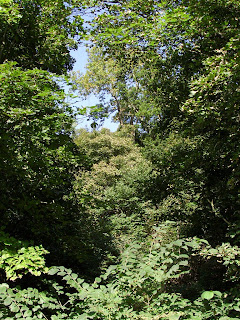
I went to galashiels' open day on friday. Galashiels is apparently one of the premier textile institutions in the country. and i want to do a degree with them
they've got loadsa cool equpment, for dying, spinning, and garment making. best of all though, is the weave room. here is one quarter of it

i was almost jumping up and down with glee when i walked through the door. and the weaving technician was very helpful and explained a few things to do with warping procedures to me. however, as i have a very poor visual imagination, i failed to take most of it in.
anyway, that's where i is going if i can. so i'm spending the rest of this year putting a portfolio together
hooray!
Comments
Weave like an Egyptian,
Jane
i still have to apply, be interviewed and accepted and make sure my first year fees are paid (having previously studied unsuccessfully, they might not pay them). as well as all that, i have to begin making preparations for finding another, afforable house. and i can't stay in halls cos i've got a dog, and a great lack of tolerance for the drunken tomfoolery one expects in such places
so, all in all, it's a great upheaval (not that i'm unaccostomed), but then i'll be able to stay there for at least 4 years, and that'll be nice. if i can find a dilapidated farm cottage with a solid wood burner that'd be perfect
however, i remain cautiously optimistic and will endevour to make a portfolio entirely out of woven materials
except for the pattern drafts i suppose, as i could find myself making pattern drafts for the fabrics that depict the pattern drafts and thus end up in an endlessly repeating loop
and the last thing i want on my hands is a paradox interupting the fabric of space time. if there's anything i've learned from my misspent youth watching star trek it's never good
also, and i never mentioned this, they have fully equipped studios for sewing, pattern making, computerised machine knitting, fabric and yarn dying, modern spinning facilities, jacquard loom, and a very very large room full of 12-24 shaft dobby-boxed floor looms
it's quite simply the coolest place i have ever been
Go for it -- it really does sound right up your alley!
Jane
Cautiously optimistic is good.
I wish I had studied weaving in college. I'd probably be a better person for it.
You will get in. I'd love to read about it as you build your portfolio.
as well as 2 4 metre lengths of 1/2ft wide multicoloured diamond twill, a large piece of that shepherds check and a bunch of rugs, i also have about 10 ickle wee samples of linen and silk and early experiments, all of which are going to be retrospectively analysed and catalogued in a book the cover of which will be made out of a rag rug and the pages and binding of either shepherds check, or bedsheeting if i feel like the easy life.
on top of that, i have my anatomy, figure drawing, portraiture and colour studies from college, which can only help
this is the *plan*, i should attempt to get all this done by december, if not january or february.
the pattern drafts i mentioned before are going to form the bones of the cataloguing effort, along with warp and weft wraps (where you put them in order of the threading and picking on a piece of folded up card) and my own probably woefully inadequate attempts at fibre analysis, based on the conversion table i've downloaded from the website of an industrial polymers manufacturer in the states.
i've seen their warp plan sheets for some of the more horrifically complex weaves, such as the fabric for the queen's footstool that they made with a jacquard that is a woven picture in many colours of the gates of holyrood palace, her home in edinburgh. these are very intimidating documents these warp plans, i don't mind telling you.
anyway, that'll keep me busy over the october holidays.
Wishing you best of luck for your weaving. Enjoy.